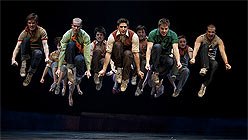Set to a kick-ass score, the 1950s story was remarkably progressive for its day. With music by Leonard Bernstein and lyrics by Stephen Sondheim, the play spoke of the realities of bigotry and the failed promise of Lady Liberty to her huddled masses.
While the 1953 play was more timid, the movie’s lyrics were right on: “Life is alright in America/If you’re all white in America/Here you are free and you have pride/Long as you stay on your own side/Free to be anything you choose/Free to wait tables and shine shoes.”
But if the 1961 movie talked the talk, the 2009 revival really does walk the walk. With the Spanish speakers actually speaking Spanish, this modern revival allows us to see the conflict from the other side of the street; we see the Puerto Ricans from the inside, not just from the side of the Xenophobe.

While much of the first half of the play suffers from unfavorable comparisons with the film, the bilingual approach begins to score some points in Act II. The audience bounces along on the bed with a gaggle of irreverent girls in “I Feel Pretty,” one of the play’s all-out best numbers. With its “oh no she di’int!” neck-rolling street-sass, the song, sung mostly in Spanish, now possesses a pajama party mood as Maria’s ga ga lovesickness is mocked by her friend’s playful teasing.

As Maria, Ali Ewoldt has a powerful, earthy voice — so different from Marni Nixon’s — the vocalist who sang Natalie Wood’s part in the film version. Both Nixon’s classical voice and Wood’s ingenue performance created an ethereal Maria, who, if we are to be honest, was kinda weak. Ewoldt’s Maria is a bit sexier; sweet but more substantial.
Kyle Harris’s Tony, however, is a little too flimsy. Harris has a terrific, beautiful voice, but as an actor — he’s a bit vacuous with his incessant pretty boy smile — like he still can’t believe he got the part.
Nonetheless, the two of them sound wonderful together and when they begin to sing a bilingual duet of “Somewhere,” it promises to be deeply moving. The integration of the Spanish and English languages — especially in this song, suggests a racial harmony that is so much less hokey than I could have imagined…
But then, inexplicably, ‘Anybodys’ — that odd tomboy character — winds up singing most of the song. ‘Anybodys,’ played here by Alexandra Frohlinger, has always been a curious role; she’s that tag along would-be Jet, who is always being told to scram and to act like a girl. Face it; she is early Hollywood’s most iconic, most thinly disguised lesbian.

In a balletic dream sequence in which Tony and Maria are free to love each other and Whites and Hispanics live in harmony, ‘Anybodys’ steps into this bright white, heavenly set, joins Tony and Maria’s hands and, although Frohlinger hardly has the vocal chops, she sings this iconic ballad.
It is at once a lousy and a daring choice. Laurents must be well aware that “Somewhere” has become a gay equality anthem of sorts in recent decades. By giving the song to the coded gay character, the message becomes political. It’s a bold choice, and the number is emotionally moving from a gay rights point of view. But it’s a wholly inorganic, anachronistic way to go with this song. By giving the song to a minor character with a disappointing voice, it robs this number of its potential to say what it should be saying.
Another number that has been updated — but remains true to its original meaning — is “Gee, Officer Krupke.” Led with off-color color by Drew Foster’s Action, The Jets deride the failed system of authority figures with much the same mischievousness as they did in earlier productions. But because it is 2010, the kids can deride the adults in an R-rated manner. The song is raunchy and edgy and while the antics are still full of ham, there’s a sense of queasy Brechtian over-kill to the vaudeville.
As I may have mentioned, some of us are fanatically devoted to the film version of West Side Story. But, even Arthur Laurents acknowledged that the acting in the movie was “the worst in any musical film.” Still, I’d like to believe that he wasn’t including Rita Moreno when he made this statement. As the firebrand “a boy like that” Anita, the Piquant “Smoke on your pipe and put that in” Anita, Rita Moreno was the bee’s knees.
So it’s worth noting that Michelle Aravena holds her own as Anita in this production. She is full of energy and personality. German Santiago is also good as Bernardo, but his performance seems short on singing and dancing and longer on fighting.

It seems that there’s not enough room for big scale leaping and Jerome Robbins-caliber dancing on the Orpheum stage. Or maybe it’s just that there’ll never be enough room to muscle out the movie in my mind.






